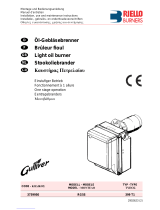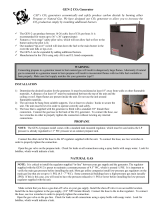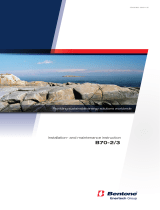
Technical description of the burner
11 6046
Tab. F
2CORRECTED BURNER AIR PRESSURE ACCORDING TO ALTITUDE
Altitude
Rated Pressure m. a.s.l. 0100 305 610 915 1220 1525 1830 2135 2440
ft a.s.l 0328 1000 2000 3000 4000 5000 6000 7000 8000
0,50 0,49 0,50 0,51 0,53 0,55 0,57 0,59 0,62 0,64 0,67
1,00 0,99 1,00 1,02 1,06 1,10 1,14 1,19 1,23 1,28 1,34
1,50 1,48 1,50 1,53 1,59 1,65 1,71 1,78 1,85 1,92 2,01
2,00 1,97 2,00 2,05 2,12 2,20 2,28 2,37 2,46 2,56 2,67
2,50 2,47 2,50 2,56 2,65 2,75 2,85 2,96 3,08 3,21 3,34
3,00 2,96 3,00 3,07 3,18 3,30 3,43 3,56 3,70 3,85 4,01
3,50 3,46 3,50 3,58 3,71 3,85 4,00 4,15 4,31 4,49 4,68
4,00 3,95 4,00 4,09 4,24 4,40 4,57 4,74 4,93 5,13 5,35
4,50 4,44 4,50 4,60 4,77 4,95 5,14 5,33 5,54 5,77 6,02
5,00 4,94 5,00 5,12 5,30 5,51 5,71 5,93 6,16 6,41 6,69
5,50 5,43 5,50 5,63 5,83 6,06 6,28 6,52 6,77 7,05 7,35
6,00 5,92 6,00 6,14 6,36 6,61 6,85 7,11 7,39 7,69 8,02
6,50 6,42 6,50 6,65 6,89 7,16 7,42 7,71 8,01 8,34 8,69
7,00 6,91 7,00 7,16 7,42 7,71 7,99 8,30 8,62 8,98 9,36
7,50 7,40 7,50 7,67 7,96 8,26 8,56 8,89 9,24 9,62 10,03
8,00 7,90 8,00 8,18 8,49 8,81 9,13 9,48 9,85 10,26 10,70
8,50 8,39 8,50 8,70 9,02 9,36 9,71 10,08 10,47 10,90 11,37
9,00 8,88 9,00 9,21 9,55 9,91 10,28 10,67 11,09 11,54 12,04
9,50 9,38 9,50 9,72 10,08 10,46 10,85 11,26 11,70 12,18 12,70
10,00 9,87 10,00 10,23 10,61 11,01 11,42 11,86 12,32 12,82 13,37
Average barometric
Pressure (20°C) mbar 1013 1000 977,4 942,8 908,2 875,8 843,5 811,85 779,8 747,8
Average barometric
Pressure (68°F) "w.c. 399 394 385 371 358 345 332 320 307 294
























